#Digital Printing Ink Market Share
Explore tagged Tumblr posts
Text
Digital Printing Ink Market Set For More Explosive Growth

The Latest research coverage on Digital Printing Ink Market provides a detailed overview and accurate market size. The study is designed considering current and historical trends, market development and business strategies taken up by leaders and new industry players entering the market. Furthermore, study includes an in-depth analysis of global and regional markets along with country level market size breakdown to identify potential gaps and opportunities to better investigate market status, development activity, value and growth patterns. Access Sample Report + All Related Graphs & Charts @: https://marketresearchforecast.com/report/digital-printing-ink-market-1303/sample-report
Major & Emerging Players in Digital Printing Ink Market:- Sun Chemical (U.S.),Siegwerk Druckfarben AG & Co. KGaA (Germany),INX International Ink Co. (U.S.),Nazdar (U.S.),DuPont (U.S.),Marabu GmbH & Co.KG (Germany),NUtec Digital Ink (Pty) Ltd. (South Africa). The Digital Printing Ink Market Study by Market Research Forecast gives an essential tool and source to Industry stakeholders to figure out the market and other fundamental technicalities, covering growth, opportunities, competitive scenarios, and key trends in the Digital Printing Ink Market. The Digital Printing Ink Market size was valued at USD 3.21 USD Billion in 2023 and is projected to reach USD 5.19 USD Billion by 2032, exhibiting a CAGR of 7.1 % during the forecast period. Digital printing ink indicates the precise ink formulations created in a digital print configuration such as the inkjet and the laser printing technologies. These dyes are the result of experiments, and they are made to give you the highest quality colors, and the fastest drying times and to be compatible with all sorts of materials, including papers, plastics, textiles, and ceramics. Digital printing ink has virtually found all different fields in the industry, such as advertising, filming, publishing, and life-objects printing, giving the capacity to print high quality on demand with no setup time and no pollution at all. Major ingredients that are used in digital printing ink formulations can be classified as pigments, binders, solvents, and additives, mainly depending on what printing technology or substrate it is needed for. The latest tendencies in the digital printing ink market are the development of zero VOC and environment–friendly formulations as well as improvements in UV-curable and water-based inks which contribute to the increased demand from customers desiring and receiving sustainable printing solutions. With the prominence of digital printing on the rise, the need for high-performance digital printing inks is going to become more and more evident. Consequently, the matching innovation and growth of the market is going to increase demand. The titled segments and sub-section of the market are illuminated below: by Type (Solvent-based, Water-based, UV-based, and Others), by Application (Textile, Ceramics, Packaging & Labels, Print Media, and Others), Forecast 2024-2032 Market Trends: Increasing demand for digital printing in various applications such as packaging, labels, textiles, and ceramics.
Growing adoption of digital printing technology in commercial and industrial sectors.
Development of new digital printing inks with improved
Challenges: High initial investment costs associated with digital printing equipment.
Limited availability of skilled labor for digital printing operations.
Concerns regarding the environmental impact of digital printing inks. Enquire for customization in Report @: https://marketresearchforecast.com/report/digital-printing-ink-market-1303/enquiry-before-buy Some Point of Table of Content: Chapter One: Report Overview Chapter Two: Global Market Growth Trends Chapter Three: Value Chain of Digital Printing Ink Market Chapter Four: Players Profiles Chapter Five: Global Digital Printing Ink Market Analysis by Regions Chapter Six: North America Digital Printing Ink Market Analysis by Countries Chapter Seven: Europe Digital Printing Ink Market Analysis by Countries Chapter Eight: Asia-Pacific Digital Printing Ink Market Analysis by Countries Chapter Nine: Middle East and Africa Digital Printing Ink Market Analysis by Countries Chapter Ten: South America Digital Printing Ink Market Analysis by Countries Chapter Eleven: Global Digital Printing Ink Market Segment by Types Chapter Twelve: Global Digital Printing Ink Market Segment by Applications What are the market factors that are explained in the Digital Printing Ink Market report?
– Key Strategic Developments: Strategic developments of the market, comprising R&D, new product launch, M&A, agreements, collaborations, partnerships, joint ventures, and regional growth of the leading competitors.
– Key Market Features: Including revenue, price, capacity, capacity utilization rate, gross, production, production rate, consumption, import/export, supply/demand, cost, market share, CAGR, and gross margin.– Analytical Tools: The analytical tools such as Porter’s five forces analysis, SWOT analysis, feasibility study, and investment return analysis have been used to analyze the growth of the key players operating in the market. Buy This Exclusive Research Here: https://marketresearchforecast.com/report/digital-printing-ink-market-1303/checkout?type=corporate Definitively, this report will give you an unmistakable perspective on every single reality of the market without a need to allude to some other research report or an information source. Our report will give all of you the realities about the past, present, and eventual fate of the concerned Market. Thanks for reading this article; you can also get individual chapter wise section or region wise report version like North America, Europe or Asia. Contact US : Craig Francis (PR & Marketing Manager) Market Research Forecast Unit No. 429, Parsonage Road Edison, NJ New Jersey USA – 08837 Phone: +1 201 565 3262, +44 161 818 8166 [email protected]
#Global Digital Printing Ink Market#Digital Printing Ink Market Demand#Digital Printing Ink Market Trends#Digital Printing Ink Market Analysis#Digital Printing Ink Market Growth#Digital Printing Ink Market Share#Digital Printing Ink Market Forecast#Digital Printing Ink Market Challenges
0 notes
Text

Seraph Serpent Birkat Habayit, 2024
a (non-)traditional blessing for the home, commissioned earlier this year as a wedding gift for a wonderful couple who share my alternative/dark-fantasy Jewish aesthetic! having just finished Esther Hamori's book God's Monsters, i was already thinking about the nachash seraphim & was excited to integrate one as a guardian here. the original piece was sketched in Procreate and then finished traditionally, but the photo i took of it before sending it off wasn't the right quality for prints, so this is actually a digital re-inking of the same piece.
it's not my usual practice to make prints of commissioned work, but the family not only graciously gave permission but in fact suggested it to me in this case! so i'll have some of these with me at my local Hanukkah market this December & will be stocking them in my shop next year.
692 notes
·
View notes
Text
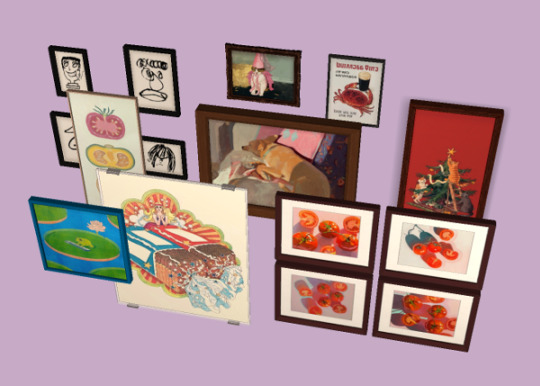


Stocking Stuffer 1/5: A Bajillion Random Painting Recolours
Happy Holidays to all! While I'm proud that last year I finally managed to achieve a longtime goal of sharing a full TS2 Advent Calendar, I'm simply not gonna be able to pull it off this year. Nonetheless, the holidlay spirit has encouraged me to finish up and share a couple of things before the end of the year! I'll be sharing five little gifts over the next few arbitrary days. First up: A BUNCH of Maxis painting recolours.
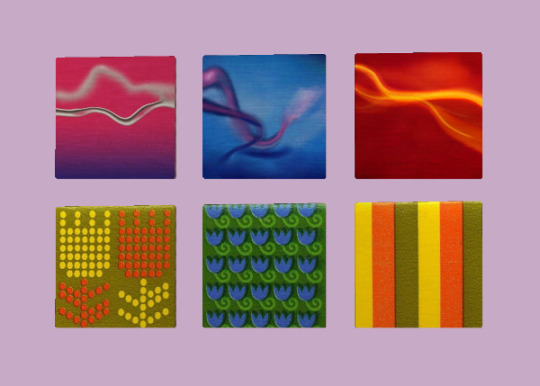
One recolour each of A/B/C Stroke (yes, I still enjoy playing with these as three separate paintings) using vintage matchbook covers designed by Saul Bass for The Ohio Match Company.

Two recolours +frames for Abstrutionism; "Poppy Cake" by Adolf Fényes (1910), and then this edit of Christina's World by Andrew Wyeth (1948) to include Bella Goth (the original Tumblr poster has deactivated).

A recolour of Anonymous Masterpiece with these two digital paintings by user chestnutroan featuring their farmer Sim and his two alien daughters.

One recolour of the Arghist Soldier with "Friday Nights" by Deborah DeWit (2006), perfect for your novel-enthusiast Sims' reading nook.
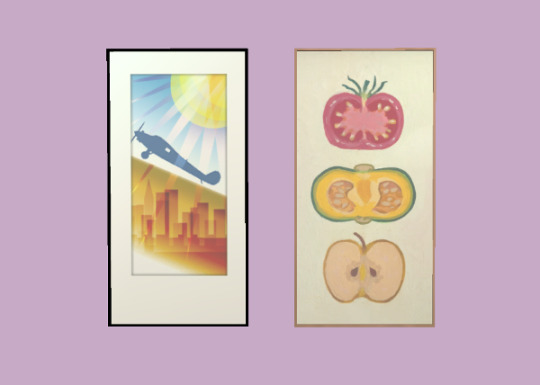
One recolour of City Skyline with a fruit & veg painting by Twitter user snail_soup (you can buy a real print of this too if you like it!)

One recolour of the Fourth Element wall scroll with "From Stardust to Stardust - Raccoon" by user ArtOfMienda.
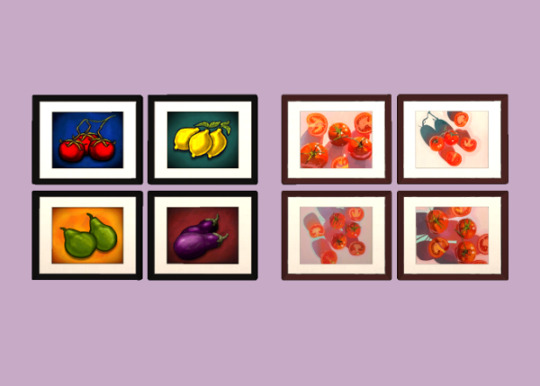
Four Vegetables recoloured with four deliciously juicy tomato paintings by artist Leah Gardner.

Geometry 101 recoloured with a beautiful palette knife painting by Lynn Boggess.

Two recolours of Grilled Cheese (you all know what Grilled Cheese looks like, c'mon); one vintage ad for Hollywood Diet bread which I cleaned/redrew to remove text/graphics, and then "Cloud Rows" by Ivan Eyre (2004).

In The Beginning (+frame) recoloured with "Little Thief" by Courtney / Trash Kitty Art (also available as an affordable IRL print).

Kitten vs. Yarn (+frame) recoloured with this goache painting by user ieafy.

"Until Tonight" by Mark Grantham (2019) slapped on Lady On Red.

Two recolours of Living Room; "Midwestern Summer Fun" by user ink-the-artist (you may wanna zoom in for a surprise), then "Girl On A Swing" (2000) by Andrew Macara.

One recolour of Marketing Print with the Beatles as drawn by other Beatles. I don't remember who drew who because I'm actually not much of a Beatles fan but I thought these sketches were really darling.

In Memory of Johnny Gnome (+frame) recoloured with a piece by Emma Roulette.

A recolour of My First Holiday with art from Twitter user heikala_art.

On Pointed Toes (+frame) recoloured with this digital painting by Twitter user catwheezie.

I fell in love with this Guinness ad so I tweaked it from the photo to fit on the Route 66 poster, then made an accompanying Simlish option.

A single Scruffles recolour (+frame) with this adorable cow illustration by Twitter user poodlewool.

Four recolours of the Sim Noir pop art print; three pieces by Al Parker I found through this Tweet (with some English removed) and then an edit of the original painting to look passingly familiar...

Two recolours (+frames) of Snoozing Enemies; "The Cat on the Pillow" by Adolf von Becker, and "Sleeping Sasha" by Lena Rivo.

Stiller Life (+frame) recoloured with this oil painting of McDonalds by artist Noah Verrier.

Two recolours (+frames) of Stumped Hound; "Shadow" by Tianyi Zhou and "cat falling off table" by user anasauruss.

The Muse recoloured with this Juxtapoz magazine cover by artist Josh Courlas.

And lastly, three recolours of Untitled (the Bella Goth pop art painting) with works by Hiroshi Nagai.
Download All Paintings @ SFS
355 notes
·
View notes
Text
Digital Visiting Card Agency In Bhubaneswar Will Simplify Your Business Communication
Having A Digital Visiting Card Agency In Bhubaneswar Will Allow You To Make Your Communication More Seamless And Effective. Wondering How? This Blog Post Will Tell Us.
Introduction:
The revolutionization of digital technology and acceptance in the business world has completely changed the marketing and promotional scenarios for every brand. Today, customers are having greater access to digital versions of physical business cards rather than opting for boring, conventional paper cards for communications.
One of the most effective networking tools this year is digital business cards. Going virtual has several tangible benefits, such as the ability to create a digital business card (and make it stand out from the crowd), sharing your business card with others, and more. With the right Digital Visiting Card Agency In Bhubaneswar, you can easily design your e-visiting card.
Digital visiting cards have been around since the early 2000s, but we have not seen much change until recently. As technology advances rapidly, we are seeing more companies adopt digital solutions in place of paper ones. In fact, many of these companies are now offering free accounts for their customers.
Why Do You Need A Digital Visiting Card?
Digital business cards are what they sound like. A digital business card is also known as a virtual business card, electronic business card, smart business card, or digital visiting card. With an iPhone, iPad, Android, or computer, you can create a digital business card. You can customize, design, and share electronic business cards.
Digital cards do not have any limits on the amount of information you can add to your card. It is up to you how much information you want to include. Additionally, you can add a photo, video, logo, social media profiles, badges, and PDFs along with your standard contact information including your name, phone number, email id, business website link, and so on.
Digital visiting cards can be accessed and viewed via any smart device. With nearly every adult in India owning smartphones and tablets, a digital card program could yield significant advantages for both consumers and retailers alike. It refines a brand’s professional image and makes your communication more streamlined and effective.
How Does A Digital Visiting Card Work?
A digital card works similarly to how a physical one does. When someone purchases your business, they enter their details into the system; then you can send them emails about special offers or events. You can also ask your Digital Visiting Card Agency In Bhubaneswar to set limits on how often people get sent promotional material.
As stated above, a digital card saves time and money over traditional paper options. People don't need to print, cut out, or laminate paper invoices anymore. A digital option means less work for you, as well as lower costs for printing, mailing, paper supplies, and labour. You can even add features like text messaging and coupon codes with digital cards.
Also, for convenience and security, many companies believe that a mobile and web-based communication solution will help them meet customer expectations and engage with them at any time. And all these are possible when you hire the best Digital Visiting Card Agency In Bhubaneswar.
Digital Business Cards: Make A Bigger Impact For Less.
In the past, business cards were limited. In the old days, two-colour or monochrome cards were printed on sheet-fed, offset presses using basic spot-colour techniques. Colour schemes with more intricate details can be achieved, but only by involving methods such as screen-printing and a process of shaping the inks, which takes a great deal of time.
As a result, the final products were lacking in definition and the colours were misaligned. However, printing on-demand, in small digital card batches has been revolutionized by the advent of digital printers. A digital business card is directly designed for online or virtual sharing without involving any printing steps or requirements in the process.
As compared to traditional business cards, e-business cards offer several advantages, including the ability to print without a printing plate, resulting in a reduction in running costs and a faster turnaround time than traditional business cards. Savings can then be passed on to both the company and the customers.
A digital business card is also more durable than a traditional card. While digital printing for digital business cards is expensive per page when compared with conventional offset printing, it avoids all the technical steps involved in making printing plates and typesetting, so the initial cost is less.
Electronic business cards are eco-friendly since they do not require paper, therefore helping the environment when you use them. With the increasing use of laptops, tablets, and advanced smartphones in households, electronic business cards are becoming more common.
Challenges Related To Digital Visiting Cards For Businesses
While some businesses may view these changes positively, others may find it challenging to change the way they do business. Entrepreneurs considering making the transition to a digital card program should begin planning now. As customers expect more convenient ways to interact with businesses, they must build a strong foundation for the future.
To ensure success, organizations should hire the best Digital Visiting Card Agency In Bhubaneswar and plan to update the information contained on their current cards (e.g., expiration dates), provide a means of accessing them online, and determine whether they need to upgrade their technology infrastructure to accommodate the shift.
Digital Visiting Cards: Where To Start?
Organizations are replacing paper business cards with digital ones. Business cards are available from a few platforms, but MoovOn Services & Solutions stands out. MoovOn is the leading Digital Visiting Card Agency In Bhubaneswar.
From small businesses to Fortune 500 companies, we offer affordable yet effective digital business cards for effective communication with individuals and companies of all sizes. Having the architecture and capability to support large enterprises makes us the best digital business card platform.
Get Started With Moovon Services & Solutions Today!
MoovOn Services & Solutions also offers a free trial for digital business cards and contact manager designs to assist you in curating and designing the perfect card. Our virtual cards are seamless, easy to share, and impactful. MoovOn is the perfect Digital Visiting Card Agency In Bhubaneswar if you want to make the switch from paper business cards to digital ones.
If you are ready, sign up for MoovOn today.
2 notes
·
View notes
Text


Hello hello and welcome to Strange Ghosts. I’m Maria (she/her), a Cincinnati-based artist, illustrator, and printmaker, whose work is inspired by mythology, folklore, witchcraft, and horror movies.
I primarily work digitally now, using programs like Procreate and Adobe Illustrator to replicate ink illustration and etching printmaking techniques, I also love soft pencil textures. I’m trained in Graphic Design and multimedia printmaking including stone and plate lithography, intaglio etching, block printing, and screen printing. I’m hoping to have the space for a printmaking studio within the next couple of years.



I am also a Norse Pagan and practicing Satanic Witch. My craft greatly influences my art and vice versa. My patron deities include Odin, Freyja, Lucifer, and Lilith (you will see these four appear frequently in my work!).
At home I am a cat mother of 3. My little familiars are all black cats, two from the same litter, and a Bengal mix. They are Merlin, Elphaba, and Lucifer.



On top of finding me and my work on a variety of social channels as well as on Etsy, you can find me in person as well. I started traveling to vend at in person conventions and markets in 2023, and I feel that this really elevated my work and creative expression. I love being surrounded by other creators, meeting new people, and being inspired by my peers. It’s a different type of challenge to expose your work to others face to face, and I credit that to a lot of my creative growth. This will be my first year vending with Oddities and Curiosities Expo and my first time traveling 8+ hours away to vend.


So, if you like witches, horror movies, magick, folklore, black cats, Halloween, and just all around spooky aesthetics, my art might be for you! The goal of this blog is to not only share my work and updates surrounding that, but to share my thoughts and what inspires me.
And of course — my blog and my art is safe and available for ALL people. This is an LGBTQIA+, BIPOC, Disabled, and Neurodivergent (and everyone in between) friendly space. Hate and bigotry of any kind will not be tolerated.
Come on in and sit for a spell! ✨🦇
0 notes
Text
Exploring Florida's Unique Business Card Design Styles
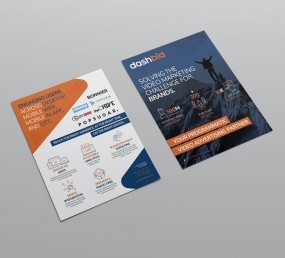
Since they function as a logo of an individual's identity and brand, business cards are crucial for professional networking. They assist people in connecting and building rapport. Thus, a well-made card is important for possible business partnerships. Hispanic, Caribbean, and Southern cultural elements are among the various that greatly affect card design in Florida. Bright colors, distinctive typeface, and imaginative layouts that capture the local surroundings and, therefore, the characteristics of the people are the outcomes of this variety. Business cards from Florida are frequently distinctive, exhibiting originality and a sense of location that appeals to both the giver and, therefore, the recipient.
Historical Context
In the US, business cards were first employed for promotion by merchants in the 17th century. Due to the impact of regional businesses like land and tourism, Florida's design styles have progressed from straightforward text-based cards to intricate designs that showcase the state's culture and wonder.
Cultural Influences
The style of business cards is influenced by Florida's varied population, which incorporates Hispanic and Caribbean groups. Design choices are greatly influenced by the tourist sector, which places a robust emphasis on aesthetic appeal and regional attractions. Indigenous patterns and tropical themes are samples of cultural elements that provide distinctiveness and significance to card designs.
Industry-Specific Styles
Florida's many businesses, like land, healthcare, and tourism, all have distinctive card designs. These cards have images and expert designs, with luxury hotel samples demonstrating their dedication to quality. These cards frequently contain elaborate designs and premium materials, demonstrating the industry's distinct branding strategy.
Color Palettes and Typography
Popular color schemes like sunset oranges and pinks, which suggest warmth and creativity, and ocean blues and greens, which evoke peace and freshness, represent Florida's nature. Trends in typography, such as handwritten styles for a private touch and sans-serif fonts for modernity, are appealing to local companies. While typography sets the tone and conveys brand values, colors foster emotional ties and improve recognition.
Innovative Materials and Techniques
The use of bizarre materials, like recycled paper, sustainable materials, metal, wood, and plastic, in the creation of business cards is examined within the book. The cards are made more luxurious and textured by using techniques like die-cutting, foil stamping, and embossing. Tech startups, creative firms, and native craftspeople are all successful samples of companies that use innovative designs. They use unique, contemporary designs to speak innovation.
Digital Business Cards
Because they're easy to share and access, digital business cards are getting more and more common as smartphone usage rises. Unlike traditional cards, which are often forgotten or misplaced, these cards are convenient and are updated instantly. Florida-based businesses are setting the quality for digital card design, with marketing agencies and IT companies developing the primary user-friendly interfaces. QR codes are frequently used during networking events for seamless digital platforms.
Sustainability practices
With the usage of recycled paper, biodegradable plastics, and plant-based inks, the trend of environmentally friendly card design is growing. Digital cards are also used to chop down paper waste. Initiatives just like the Miami Beach Eco-Design Awards encourage sustainable practices, and native companies like Print It USA are setting the quality. Customers' perceptions of environmentally conscientious firms could also be improved by using sustainable design to extend brand loyalty and attract eco-aware customers.
Tips for Creating a Unique Card
This blog offers advice on the way to design a particular card, stressing the importance of layout, color schemes, font, and tactile components. It highlights how important it is to match the planning to the target market, mission, and values of the brand. Brand identification is strengthened when all marketing materials are consistent. A business card design company in Florida like Print It USA is a good place to seek out ideas and expert design services.
Conclusion
Florida's distinctive card designs uphold professionalism while highlighting the importance of regional trends. These designs improve networking possibilities and private branding. Additionally, to serve as a way of exchanging contact details, a well-designed card is a crucial component of a knowledgeable persona that will make an impact.
0 notes
Text
Why Specialty Carbon Black is More Than Just Pigment
Carbon Black Market Size
Market Overview
Technological advancements and evolving market demands are driving a profound transformation in the Specialty Carbon Black Market. This report offers a strategic roadmap, providing businesses with a comprehensive analysis of emerging trends, key growth drivers, and potential obstacles. Our data-driven insights, spanning from 2025 to 2033, focus on vital aspects such as pricing strategies, adoption rates, product innovation, and regional market penetration.
Key Market Insights
Growth Projection: The Specialty Carbon Black Market is projected to grow at a compound annual growth rate of (CAGR) of 6% between 2024 and 2033.
Market Valuation: By 2033, the market is expected to reach a valuation of $XXX billion.
Key Drivers: Technological innovations, changing regulatory landscapes, and evolving consumer preferences are influencing the market growth.
Access the Full Report: Request a Sample Report
Transformative Trends Shaping the Specialty Carbon Black Market
Staying competitive in the Specialty Carbon Black Market requires an understanding of key trends that are reshaping the landscape. Below are some of the most significant shifts:
1. The Rise of Smart Technologies and Digital Transformation
AI-powered automation and analytics are enhancing productivity and streamlining client interactions.
Businesses leveraging IoT and big data are gaining a competitive edge by optimizing operations and decision-making.
2. Personalization and Customization: A Growing Demand
Consumers’ increasing preference for personalized solutions is pushing companies to innovate in product offerings.
Customizations are becoming a game-changer, offering businesses new ways to meet consumer expectations and stand out in the market.
3. Navigating the Complex Regulatory Environment
Government regulations are reshaping cost structures and operational strategies across industries.
Adapting to new compliance standards is crucial for companies aiming for long-term sustainability in the market.
Competitive Landscape: Leading Players in the Specialty Carbon Black Market
Understanding the competitive dynamics in the Specialty Carbon Black Market is essential for informed decision-making. This section analyzes the forces shaping the industry and presents a SWOT analysis of the top key players driving market growth.
Leading Companies in the Specialty Carbon Black Market
Orion Engineered Carbons
Cabot Corporation
Birla Carbon
Denka Company
Phillips Carbon Black
Mitsubishi Chemical
Tokai Carbon
China Synthetic Rubber
Imerys
Shandong Huibaichuan New Materials
Shanxi Fulihua Chemical Materials
Beilum Carbon Chemical
Shandong Emperor-Taishan Carbon
Zaozhuang Xinyuan Chemical Industry
Sid Richardson Carbon & Energy
Omsk Carbon Group
Xiahuayuan Xuguang Chemical
Geotech International
Strategic Moves: The latest mergers, acquisitions, and partnerships influencing market share.
Market Share Analysis: How the dominant players are strengthening their positions in the market.
Growth Potential: Identifying emerging opportunities for new entrants and existing players.
Explore the Full Competitive Report: Access the Report
Market Segmentation: Uncovering High-Growth Opportunities
Understanding the market segmentation is critical for companies aiming to refine their strategies. Our research breaks down the Specialty Carbon Black Market based on
Segment By Type
Lamp Black
Acetylene Black
Gas Black
Others
Segment By Application
Plastics
Printing Ink
Paint
Other Application
Regional Market Demand: The Biggest Growth Markets
Each region offers unique growth opportunities and challenges. This section provides an in-depth look at regional demand trends, market drivers, and the factors influencing expansion across key geographies.
North America
Europe
Asia-Pacific
Latin America
The Middle East and Africa
Purchase the Full Report Now: Buy Now
Why Choose Our Research?
Data Accuracy: Our research relies on verified sources and rigorous validation techniques.
Comprehensive Research Approach: Combining primary research (interviews, surveys) with secondary data for an accurate market overview.
Industry Expertise: In-depth knowledge from domain experts provides actionable insights for your business.
AI-Powered Analytics: State-of-the-art tools ensure precise market forecasting and insights.
Ethical Practices: Our reports are transparent, unbiased, and focused on delivering reliable market intelligence.
Frequently Asked Questions (FAQs)
What is the projected growth rate of the Specialty Carbon Black Market?
What are the primary factors driving the expansion of the Specialty Carbon Black Market?
What challenges are currently hindering the growth of the Specialty Carbon Black Market?
How is the market segmented, and which segments are expected to experience the most growth?
Which regions are leading the demand for Specialty Carbon Black Market, and why?
About Market Strides
Market Strides is a leading provider of global market intelligence, specializing in research reports across various industries. Our expertise lies in market sizing, competitive analysis, and trend forecasting, empowering businesses to make data-driven decisions and stay ahead of market trends.
Contact Us: [email protected]
#Specialty Carbon Black Market Size#Specialty Carbon Black Market Share#Specialty Carbon Black Market Growth#Specialty Carbon Black Market Trends#Specialty Carbon Black Market Players
0 notes
Text
Building Faster, Smarter, And Better: The Power Of Automated Takeoff & Estimating
The construction industry is evolving rapidly, with technology transforming traditional processes into more efficient and streamlined operations. One key advancement is the adoption of construction quantity takeoff solutions that automate estimating tasks. These tools enable contractors and estimators to work smarter, faster, and more accurately than ever before.

The Evolution of Construction Estimating: From Manual to Automated
Historically, construction quantity takeoff involved manual processes like measuring paper blueprints with scales and digitizer tablets. This method was time-consuming, prone to human error, and required substantial resources. Today, automated takeoff software has revolutionized the industry. By leveraging digital technology, estimators can eliminate inefficiencies and focus on delivering accurate results quickly.
What is Automated Takeoff and How Does It Work?
Automated takeoff is a technology-driven process where quantities for materials, areas, and items are extracted directly from digital drawings and models. Using tools like on-screen digitizing software or Building Information Modeling (BIM), estimators can perform accurate measurements without manual intervention. Simply upload digital files like PDFs, DWGs, or TIFs, and the software calculates measurements automatically, ensuring precision and speed.
Why Automation is Critical for Modern Construction Projects
Modern construction projects require efficiency and accuracy due to increasing complexities and tight deadlines. Manual takeoff methods are no longer sufficient to meet these demands. Automated takeoff solutions not only reduce errors but also save time and money, making them critical for staying competitive in today’s market. By automating repetitive tasks, construction professionals can focus on strategic planning and project execution.
Key Benefits of Automated Takeoff and Estimating Software
The adoption of automated estimating software offers several key advantages:
Time Savings: Automated tools majorly reduce the time spent measuring and calculating quantities.
Accuracy: Precision is enhanced as errors caused by manual measurements are eliminated.
Cost Efficiency: Reduced reliance on paper plans, digitizer tablets, and manual efforts lowers overall project costs.
Scalability: Whether working on small projects or big-scale construction, automated tools can adapt to various project sizes.
Improved Collaboration: Digital files are easily shareable, allowing seamless collaboration among teams and stakeholders.
Automating the Takeoff Process
Today, there are two different ways to perform takeoffs for new construction projects: using paper blueprints or digital files. While paper blueprints stem from digital files, working directly with digital files offers notable benefits:
Cost savings on paper, ink, and printing expenses. Mobility and flexibility to perform takeoffs anywhere with a laptop. Cleaner organized workspaces with fewer storage requirements for bulky blueprints. Lower costs as expensive digitizer tablets are unnecessary.
On-Screen Digitizing from Drawing Files
A well-designed on-screen digitizing program allows users to view various file formats like DWG, DWF, TIF, and PDF. Measurements are performed using a computer mouse instead of scales or digitizer tablets. These tools also allow:
Customize line styles, colors, and symbols for better clarity. Seamless integration with MS Excel for precise quantity recording and estimation. Accurate measurement recording into the appropriate spreadsheet cells.
Automatic Takeoff Using BIM (Building Information Modeling)
BIM is a rapidly developing technology in the architecture, engineering, and construction industries. It allows for data sharing, seamless transfers, and enhanced collaboration. Design-build contractors are early adopters of BIM-based quantity extraction, but industry-wide adoption is still evolving. Staying updated on BIM advancements can help businesses capitalize on this emerging trend.
Finding the Right Provider
When selecting an automated takeoff and estimating solution, it is important to choose a reliable provider. Vertigraph, Inc. is recognized as one of the most trusted names in the industry. Known for offering top-tier automated estimating software, Vertigraph ensures accuracy, efficiency, and ease of use for construction professionals of all levels.
Conclusion
Automating the construction quantity takeoff process is no longer a luxury—it is a necessity for success in the modern construction landscape. By embracing tools like on-screen digitizing and BIM, companies can build smarter, faster, and better. The right automated solution, such as those provided by Vertigraph, Inc., can make a significant difference in achieving project efficiency and cost-effectiveness.
0 notes
Text
Ink Receptive Coatings Market Growth Analysis and Share Insights for Key Industry Players in 2025.
The ink receptive coatings market has witnessed substantial growth in recent years, driven by a surge in demand for high-quality printing materials in various industries. Ink receptive coatings are essential components in the printing process, improving the ink's adhesion to substrates like paper, textiles, plastic, and ceramics. These coatings provide enhanced print quality, increased durability, and better ink efficiency, which makes them a valuable component in sectors such as packaging, textiles, and advertising. As a result, the global ink receptive coatings market share has experienced significant expansion, with growing adoption across both traditional and digital printing applications.

Key Factors Driving Market Growth
Increasing Demand for Printed Materials The rise of the e-commerce industry has led to an upsurge in demand for printed packaging materials. Ink receptive coatings play a crucial role in enhancing the appearance and durability of these products. As online shopping continues to grow globally, there is an increased demand for high-quality printed materials that make products stand out, further boosting the market for ink receptive coatings.
Technological Advancements in Printing Digital printing technologies, such as inkjet and laser printing, have transformed the printing landscape. These advancements require coatings that are specifically designed to optimize the performance of modern printers. Ink receptive coatings are tailored to ensure that the ink adheres correctly, resulting in sharper images and clearer text. With the growing trend of digital printing, the demand for innovative coatings is set to rise.
Environmental Concerns and Sustainability With a growing emphasis on sustainability, industries are seeking eco-friendly ink solutions. Ink receptive coatings have evolved to meet these environmental standards, with many products now being manufactured using water-based or UV-cured formulations. These advancements not only reduce environmental impact but also cater to the demand for greener printing solutions, further driving the market.
Rising Applications in Textiles and Packaging The textile industry has seen a significant shift towards digital printing techniques, where ink receptive coatings play an important role in ensuring vibrant, durable prints. Similarly, the packaging sector has adopted these coatings extensively to improve the visual appeal and longevity of printed materials. The increasing application of ink receptive coatings in both textiles and packaging is expected to continue driving market growth in the coming years.
Expansion of the Automotive and Electronics Industries As the automotive and electronics industries expand, the demand for high-quality printed components in areas like dashboards, touch panels, and displays grows. Ink receptive coatings are crucial in these industries to ensure that the printed designs and labels remain intact and visible under different environmental conditions. This growing demand in non-traditional sectors has created new growth opportunities for the ink receptive coatings market.
Regional Market Trends
North America and Europe currently hold significant shares in the global ink receptive coatings market, owing to their strong presence in the printing and packaging industries. These regions also boast some of the most advanced printing technologies and a high demand for sustainable printing solutions. Asia-Pacific is expected to witness the fastest growth due to rapid industrialization, an increasing number of manufacturing hubs, and the growing demand for digital printing in emerging economies like China and India.
Competitive Landscape
The ink receptive coatings market is highly competitive, with numerous players offering a range of products tailored for different industries. Some of the leading manufacturers in the market include DowDuPont, BASF SE, Sun Chemical Corporation, and Koninklijke DSM. These companies are focusing on product innovation and expanding their portfolios to capture a larger market share. Partnerships, mergers, and acquisitions are also common strategies used to enhance their market presence and diversify their product offerings.
Future Outlook
Looking ahead, the ink receptive coatings market is expected to continue its upward trajectory. As digital printing technologies evolve and demand for sustainable solutions intensifies, the market will likely experience further growth. Moreover, the increasing adoption of ink receptive coatings in the automotive, electronics, and textile sectors will provide additional growth avenues. Innovations in product formulations and the continuous demand for high-quality prints will drive the market's evolution over the next decade.
Conclusion
The ink receptive coatings market is poised for significant growth as industries continue to embrace advanced printing technologies and sustainable solutions. With a strong demand from sectors like packaging, textiles, and electronics, this market is expected to thrive in the coming years. As technological innovations continue to shape the printing landscape, the role of ink receptive coatings will become even more critical in ensuring high-quality, durable, and eco-friendly prints across various applications.
0 notes
Text
Top 15 Market Players in Global Pigment Wetting Agents Market

Top 15 Market Players in Global Pigment Wetting Agents Market
The global pigment wetting agents market is driven by major companies focusing on innovative product development, sustainability, and diverse applications across industries. Below are the top 15 players shaping this dynamic market:
BASF SE A market leader offering advanced pigment wetting agents designed for paints, coatings, and inks with superior dispersion properties.
Dow Inc. Known for its high-performance wetting agents tailored for industrial and decorative coating applications.
Evonik Industries AG Provides a wide range of surfactants and wetting agents that enhance pigment dispersion and coating quality.
Ashland Global Holdings Inc. Offers innovative pigment wetting agents with a focus on waterborne and sustainable coating systems.
Clariant AG A key player providing high-quality additives, including wetting agents, for improved pigment stability and performance.
Solvay S.A. Specializes in advanced wetting agents that improve pigment dispersion in coatings and printing applications.
Stepan Company Renowned for its surfactants and dispersing agents, Stepan provides versatile solutions for pigment wetting.
Croda International Plc Focuses on sustainable and bio-based wetting agents for the coatings and printing industries.
BYK-Chemie GmbH A leading producer of pigment wetting agents and additives for high-performance industrial applications.
Arkema S.A. Offers innovative wetting and dispersing agents to improve the efficiency of pigment usage in coatings.
Elementis Plc A prominent player offering specialty additives, including pigment wetting agents for advanced formulations.
Eastman Chemical Company Provides tailored wetting agents designed to optimize pigment dispersion in various coating applications.
Lubrizol Corporation Renowned for its innovative technologies in wetting agents that enhance color strength and uniformity.
Shin-Etsu Chemical Co., Ltd. A global supplier of additives, including advanced pigment wetting agents, for paints and inks.
Honeywell International Inc. Offers unique wetting agents to improve pigment dispersion and enhance the durability of coatings.
Request report sample at https://datavagyanik.com/reports/global-pigment-wetting-agents-market-size-production-sales-average-product-price-market-share/
Top Winning Strategies in Pigment Wetting Agents Market
Leading players in the pigment wetting agents market employ strategic approaches to stay competitive and meet evolving customer demands. Here are the top strategies:
Product Innovation Companies focus on developing wetting agents with improved pigment dispersion, better adhesion, and compatibility with eco-friendly systems.
Sustainability Initiatives Developing bio-based and low-VOC wetting agents to meet environmental regulations and cater to sustainable coating systems.
Application Diversification Expanding the use of wetting agents beyond coatings and inks to industries like plastics, construction materials, and textiles.
Regional Expansion Strengthening presence in emerging markets such as Asia-Pacific and Latin America, where industrial growth is robust.
Customization Providing tailor-made wetting agents to meet the specific needs of customers in different applications.
Technological Advancements Leveraging nanotechnology and other advanced techniques to improve the performance of pigment wetting agents.
Collaborative Partnerships Partnering with coating manufacturers and raw material suppliers to co-develop innovative solutions for end-use industries.
R&D Investments Increasing spending on research and development to enhance the efficiency, stability, and eco-friendliness of wetting agents.
Cost Optimization Streamlining production processes to reduce manufacturing costs and provide competitive pricing in cost-sensitive markets.
Marketing and Branding Leveraging digital marketing strategies and trade shows to increase brand awareness and promote new product launches.
Focus on High-Growth Segments Targeting fast-growing industries such as automotive, construction, and packaging to capitalize on rising demand for high-performance coatings.
Acquisitions and Mergers Acquiring regional players and niche manufacturers to expand product portfolios and market presence.
Compliance with Regulations Ensuring that products meet international safety and environmental standards such as REACH and EPA requirements.
Customer Support and Training Providing technical support and training to customers to optimize the use of pigment wetting agents in their applications.
Digital Transformation Implementing digital tools for supply chain management, customer engagement, and product innovation to enhance operational efficiency.
By implementing these strategies, market players can address emerging challenges, seize new opportunities, and maintain leadership in the evolving pigment wetting agents market.
Request a free sample copy at https://datavagyanik.com/reports/global-pigment-wetting-agents-market-size-production-sales-average-product-price-market-share/
#Pigment Wetting Agents Market#Pigment Wetting Agents Production#market growth#market share#market players#market size#top trends#revenue#average price#competitive pricing strategies
0 notes
Text
Top Academic Publishing Trends in 2025
What is academic publishing? In a nutshell, academic publishing is a subfield of publishing and involves the distribution of scholarly content, typically published in journals and books or as a thesis. The impact of evolving technology can be felt in academic publishing through the incorporation of new elements that optimize the workflow and expand and improve the readership. The following are some of the scholarly publishing trends that will likely determine how academic publishing workflows evolve in 2025.
Digital Transformations
The changing data systems and the necessity for new technologies reiterate the importance of a flexible infrastructure. Consider the gradual replacement of legacy data systems to improve data analytics and subsequent data-driven decisions. Investing in digital core systems and processes will be pivotal in driving innovation and enhancing the efficiency of academic publishing.
Artificial Intelligence
Artificial intelligence, or AI, tools have been integrated into workflows for manuscript screening, plagiarism detection, reference checking, language polishing, and matching peer reviewers. AI-generated content has become more prevalent in recent years owing to its improved efficiency. Hybrid works, where researchers collaborate with AI, can offer something new. The ethical question of who owns AI content prevails, though, influencing how we navigate this critical aspect. We can expect an industry-wide ethical guideline framework that regulates the extent of AI usage and related aspects, including data privacy. AI has the potential to reshape academic publishing, offering new solutions and unlocking opportunities for growth and enhanced workflows.
Open Access and Data-Sharing Policies
Plan S and Plan U have been urging for open access (OA) policies across the industry. OA is set to dominate the industry in 2025, with more and more publishers accepting it as a successful business model. Stricter data-sharing policies, mandated by institutions and funders, will drive better research reproducibility. Preprint publications enable faster dissemination of research and establish priority as usual. Creating metrics that supplement the impact factor with other parameters will give us a better insight.
Peer Review and Blockchain Technology
We are also moving toward open peer review, which increases the accountability for authors and reviewers. Blockchain technology can be used for reviews to ensure transparency in research. Early-career researchers can benefit from these open policies.
Sustainability
Sustainability is a major goal for any industry in 2025. As publishers are increasingly adopting more sustainable practices, we are moving away from printed copies by going digital or selectively printing publications. Apart from recycled paper and eco-friendly inks, eBooks and audiobooks are great alternatives.
Social Media Marketing
B2C strategies are gaining popularity among publishers, and social media platforms are emerging as key tools for promotion. Online forums and communities allow interaction and exchange of views between users, facilitating the targeted delivery of research findings and literature to niche audiences. This fosters global collaboration, bringing experts from different fields together. Social media can also be used as tools to improve the discoverability of a publication and to spread awareness about new business models and funding systems.
eLearning
In 2025, eLearning will be more immersive, interactive, and experiential, with the use of multimedia, digital learning platforms, games, and virtual and augmented reality in publications. AI and machine learning will allow hyper-personalization, tailoring learning experiences for every individual. We have yet to explore the potential of conversational search tools, AI assistants, and chatbots.
Succeeding in this dynamic industry becomes easy with the right partnerships. Elevate your scholarly content with Amnet; from developmental editing to final check, we provide end-to-end solutions that support your research every step of the way and help you navigate the complexities of academic publishing with expertise and precision. Our experts are always available to carefully incorporate all the right elements into your content to make it 2025 ready.
0 notes
Text
A Comprehensive Overview of Stationery Products Market Landscape
The global stationery products market size is expected to reach USD 151.96 billion in 2030 and is projected to grow at a CAGR of 4.4% from 2024 to 2030. Rapid rise in the number of educational institutions and inclination of the young population towards higher education across the globe are the prominent factors for the market growth.
The paper based segment held the largest share of 30.6% in 2023. Despite digitization hitting the industries, the usage of paper for printing remains the same. Growth in the number of coaching institutions in countries such as India is also likely to driving the segment in the forecast period. The ink based segment is expected to expand at the fastest CAGR of 4.9% over the forecast period. Growing trend of luxury pens as a status symbol is driving the market. Furthermore, product innovation is found to be the prominent factor for the market growth. For instance, introduction of waterproof ink pens and RGB pens has fuelled the market growth.
Educational institute is the largest application segment and it accounted during forcast. Rapid rise in the number of schools and colleges in rural areas has driven the segment. The corporate sector is anticipated to expand at a CAGR of 5.3% over the forecast period. High usage of items such as paper, staplers, and adhesives in the government sector as well in the private corporate sector is driving the market.
Asia Pacific is the largest regional stationery products market and the region accounted for 32.7% share of the overall revenue in 2023. India is one of the leading markets. Growing usage of the product in the rural areas due to replacement of traditional methods with the new stationery items is propelling the market growth in the region.
Gather more insights about the market drivers, restrains and growth of the Stationery Products Market
Stationery Products Market Report Highlights
• The paper based segment led the stationery products market and held a share of 30.6% in 2023
• Countries such as South Africa and Saudi Arabia are projected to witness significant growth due to growing trend of education, which has led to an increase in the number of educational institutes
• By application, educational institutes are expected to witness the fastest growth in the forecast period.
Stationery Products Market Segmentation
Grand View Research has segmented the global stationery products market report based on product, application, and region:
Stationery Products Product Outlook (Revenue, USD Million, 2018 - 2030)
• Paper Based
• Ink Based
• Art Based
• Others
Stationery Products Application Channel Outlook (Revenue, USD Million, 2018 - 2030)
• Educational Institutes
• Corporates
• Others
Stationery Products Regional Outlook (Revenue, USD Million, 2018 - 2030)
• North America
o U.S.
• Europe
o Germany
o UK
• Asia Pacific
o China
o Japan
• Latin America
o Brazil
• Middle East and Africa (MEA)
o Saudi Arabia
Order a free sample PDF of the Stationery Products Market Intelligence Study, published by Grand View Research.
#Stationery Products Market#Stationery Products Market Size#Stationery Products Market Share#Stationery Products Market Analysis#Stationery Products Market Growth
0 notes
Text
Best digital NFC business card services of Mumbai (Maharashtra)
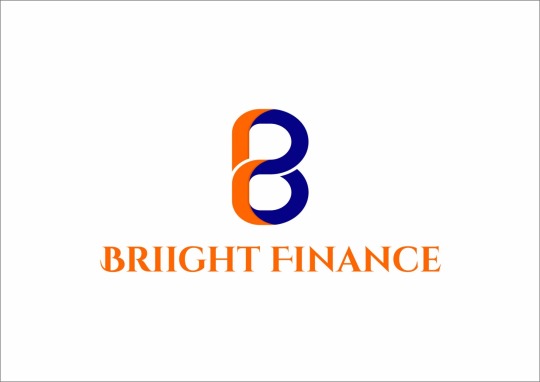
Best Digital NFC Business Card Services of Maharashtra
In the fast-paced world of networking and business communication, the need for innovative and efficient tools has never been greater. Traditional business cards, though still in use, have limitations in terms of space, ease of sharing, and updating information. With the rise of digital transformation, the demand for digital NFC (Near Field Communication) business card services is growing rapidly. Maharashtra, a hub for business and technology, has emerged as a leader in providing such advanced services, revolutionizing how professionals exchange and store contact details.
What are NFC Business Cards?
An NFC business card is a modern, contactless version of the traditional business card. These digital cards use NFC technology, which allows users to share their contact details and other professional information with a simple tap of their card to a smartphone or NFC-enabled device. The benefits of these cards extend beyond mere convenience—they enable quick updates, reduce the need for physical cards, and ensure that all information shared is accurate and up-to-date.
NFC technology uses radio waves to transmit data between two devices in close proximity, allowing for seamless data exchange. When a professional taps their NFC card on a recipient's phone, the recipient’s device will instantly open a profile with the sender's details, which could include their name, job title, contact information, social media links, and more.
Advantages of Digital NFC Business Cards
Sustainability: One of the biggest selling points of digital NFC business cards is their eco-friendliness. Unlike traditional business cards, which require paper and ink, digital cards significantly reduce paper waste. This aligns with the growing global push for sustainable business practices.
Convenience: Sharing and receiving digital cards is a fast and efficient process. A tap of the NFC-enabled card to a smartphone or device ensures that there is no need to manually type in contact information, avoiding potential errors.
Real-time Updates: One of the challenges with traditional business cards is that the information printed on them becomes outdated over time. With digital NFC cards, users can update their information on their profiles at any time, ensuring that contacts always have the most current data.
Cost-Effective: Digital NFC business cards eliminate the need for reprinting cards every time you make a change or run out of stock. Additionally, there are no costs related to paper or printing.
Customization: Many NFC business card services offer customization options, allowing professionals to add logos, colors, and other design elements that reflect their personal or company brand. This customization not only enhances the professionalism of the card but also makes it more memorable.
Integration with CRM and Analytics: Some digital NFC business card platforms come with built-in customer relationship management (CRM) integration, offering the ability to track when and where your card has been shared. This data can be invaluable for business owners looking to analyze and optimize their networking efforts.
Growing Popularity in Maharashtra
Maharashtra, a state with a rich history of innovation and entrepreneurship, is one of the leading regions in India where digital NFC business card services are rapidly gaining popularity. Cities like Mumbai, Pune, and Nagpur are home to tech-savvy professionals who are always looking for ways to streamline their business practices and stay ahead of the curve.
As the heart of India’s business and financial industries, Maharashtra is seeing a surge in the adoption of digital business card solutions. With the increasing emphasis on tech-driven business environments, more professionals in sectors such as IT, marketing, finance, and consulting are choosing NFC business cards as part of their networking toolkits.
Key Features of Digital NFC Business Card Services in Maharashtra
The best digital NFC business card services in Maharashtra typically offer a range of advanced features tailored to meet the needs of modern professionals:
One-Tap Sharing: These services ensure that sharing your contact details is as simple as a tap. The recipient does not need to install any app or software to receive the information—only a tap on the phone is required, making the process quick and intuitive.
Digital Profiles: Instead of relying on a physical card, digital NFC business cards are linked to an online profile that can contain comprehensive information about the individual or company. This can include everything from professional skills and certifications to links to social media profiles, portfolios, and websites.
Compatibility with Multiple Devices: Since NFC technology is widely supported across various devices, users can easily share their digital business cards with virtually any NFC-enabled smartphone. This makes NFC cards an attractive option in diverse professional environments.
Secure Data Sharing: As digital cards are stored and shared in a secure, encrypted environment, they offer greater privacy and security than traditional paper business cards, which can be easily lost or stolen. Additionally, recipients can access your profile without needing to manually input or store any data.
Interactive Elements: Some NFC business card services in Maharashtra allow users to embed videos, documents, and other multimedia content in their profiles. This can add a layer of interactivity that is impossible with traditional paper cards, providing additional value for those networking within industries such as media, entertainment, and tech.
The Future of Digital NFC Business Cards in Maharashtra
As businesses continue to shift towards more sustainable and efficient solutions, the future of NFC business cards in Maharashtra looks promising. The tech-savvy population of the state, particularly in urban centers like Mumbai, Pune, and Navi Mumbai, is likely to see a greater adoption of digital business cards. The rise of contactless technology, combined with the growing desire for eco-friendly and cost-effective solutions, is pushing professionals to embrace NFC cards.
Moreover, with the COVID-19 pandemic accelerating the shift towards contactless and remote communication, digital NFC business cards have gained even more relevance. As businesses look for safer alternatives to in-person exchanges, the demand for NFC technology is expected to continue its upward trajectory.
Conclusion
The shift towards digital NFC business card services in Maharashtra is transforming the way professionals connect and exchange information. These cards offer a range of benefits, from sustainability to ease of use and real-time data updates, making them an ideal solution for modern networking needs. As the region continues to foster innovation in business and technology, the best digital NFC business card services in Maharashtra are poised to revolutionize the way business relationships are built and maintained. For anyone looking to stay ahead of the curve in today’s digital age, adopting NFC business cards is undoubtedly the smart choice.
#NFC business card india#NFC business card online#Best nfc business card for small business#Best nfc business card in india#Best digital business card#Best NFC Business card Services in Gujarat#Best Digital Visiting Card Services of MAHARASHTRA
0 notes
Text
Business Card Printing in the UK: Your Guide to Making a Lasting Impression
In the age of digital communication, business cards remain a cornerstone of professional networking. Whether you're meeting potential clients, attending a trade show, or simply connecting at a local event, a well-designed business card can leave a lasting impression. Here, we explore the essentials of business card printing in the UK, helping you create cards that not only look great but also reflect your brand’s identity.
Why Business Cards Still Matter
Despite advancements in technology, business cards serve as a tangible representation of your brand. They offer:
Professionalism: Handing over a well-crafted business card exudes confidence and credibility.
Memorability: A unique design ensures that your contact details stand out among the competition.
Convenience: Business cards are portable, quick to share, and don't rely on internet connectivity.
Choosing the Right Printing Service
In the UK, the market is filled with printing services offering various options. Here’s how to choose the right one:
Reputation: Opt for printers with excellent reviews and a proven track record of quality.
Customisation Options: Look for services that allow you to choose card sizes, paper types, finishes, and printing techniques.
Turnaround Time: Ensure the service can meet your deadline, especially for urgent projects.
Eco-Friendly Options: Many UK printers now offer sustainable printing solutions, using recycled paper and vegetable-based inks.
Designing Your Business Card
A well-designed business card should be:
Clean and Simple: Avoid clutter and focus on essential details such as your name, title, company, and contact information.
Brand-Aligned: Use your brand’s colours, fonts, and logo for a cohesive identity.
Readable: Choose fonts that are clear and legible, even at smaller sizes.
Attention-Grabbing: Incorporate unique elements like spot UV, embossing, or foil stamping for a premium feel.
0 notes
Text
Digital Printing Market
Digital Printing Market Size, Share, Trends: HP Inc. Leads
Sustainable Printing Solutions Gain Traction as Eco-Conscious Consumers Drive Demand for Greener Alternatives
Market Overview:
The global digital printing market is rapidly expanding, projected to grow at a CAGR of 6.2% from 2024 to 2031, reaching USD 35.7 billion by 2031. Asia-Pacific dominates the market due to increasing adoption in textile and packaging industries, rising demand for personalized products, and a growing e-commerce sector. The industry is shifting from traditional printing technologies to digital alternatives, driven by technological advancements, demand for eco-friendly solutions, and the rise of on-demand printing. Key drivers include the need for reduced contamination risk, lower capital investment, and faster setup times.
DOWNLOAD FREE SAMPLE
Market Trends:
Sustainable printing solutions are gaining traction as eco-conscious consumers drive demand for greener alternatives. Companies are investing in environmentally friendly inks, energy-efficient printers, and recyclable substrates to lower their carbon footprints. For instance, HP Inc.'s Latex R Series printers use water-based inks to produce odorless prints with reduced environmental impact. This trend is further supported by the rising demand for sustainable packaging solutions in the e-commerce sector.
Market Segmentation:
Inkjet technology dominates the digital printing market, accounting for over a significant share of the global market. Its versatility, cost-effectiveness, and ability to print on various substrates have made it the preferred choice in multiple industries. Inkjet technology has seen significant advancements in print quality, speed, and color accuracy, expanding its applications to textiles, ceramics, and even 3-D printing. The commercial printing industry benefits from inkjet's capability to handle print-on-demand services, reducing inventory costs while offering a wide range of titles. Its growing popularity in the packaging industry, particularly for producing high-quality, personalized labels and packaging, further strengthens its market dominance.
Market Key Players:
The digital printing market is fiercely competitive, with several key players driving innovation and growth. Leading companies include:
HP Inc.
Canon Inc.
Xerox Corporation
Konica Minolta, Inc.
Ricoh Company, Ltd.
EFI, Inc.
Contact Us:
Name: Hari Krishna
Email us: [email protected]
Website: https://aurorawaveintellects.com/
0 notes
Text
Exploring Digital Signage Solutions for Modern Advertising
In the rapidly evolving landscape of advertising, digital signage has emerged as a powerful tool for modern businesses. With its ability to captivate audiences through dynamic and engaging displays, digital signage is reshaping how businesses communicate their message. At Signage Mates, we specialize in offering cutting-edge digital signage solutions tailored for businesses in Brisbane and the Gold Coast, helping them connect with their audience and achieve impactful results.

The Rise of Digital Signage in Advertising
Digital signage utilizes electronic displays like LED screens, interactive kiosks, and video walls to showcase promotional content, real-time updates, and more. Unlike static signage, it offers flexibility, interactivity, and eye-catching visuals that cater to the tech-savvy audience of today.
Benefits of Digital Signage for Businesses in Brisbane and Gold Coast
1. Enhanced Engagement: Digital signage attracts attention more effectively than traditional signs. Its vibrant visuals and movement are designed to capture and hold viewers’ interest.
2. Real-Time Updates: Unlike printed signage, which requires time and costs to update, digital signage allows instant content changes. This feature is invaluable for time-sensitive promotions and announcements.
3. Cost Efficiency: Although the initial setup costs may be higher than traditional signage, digital signage eliminates the recurring expenses of printing and replacing static signs. Over time, it proves to be a more economical option.
4. Increased Reach: For businesses in busy areas like Brisbane’s central business district or Gold Coast’s tourist hotspots, digital signage maximizes visibility by catching the eye of passersby, commuters, and visitors.
5. Sustainability: With environmental concerns on the rise, digital signage offers an eco-friendly alternative to printed materials. By reducing paper waste and ink usage, businesses contribute to sustainability while enhancing their advertising strategies.
Applications of Digital Signage
1. Retail: Digital signage enhances the shopping experience by promoting deals, providing product information, and even guiding customers through large stores.
2. Hospitality: Hotels, restaurants, and event venues leverage digital signage to welcome guests, promote services, and share schedules or menus.
3. Healthcare: Hospitals and clinics use digital signage to share health tips, guide patients, and reduce perceived waiting times by displaying engaging content in waiting areas.
4. Corporate Offices: In corporate environments, digital signage is used for internal communication, showcasing performance metrics, or displaying motivational content.
Digital Signage Trends in 2024
1. Interactive Signage: Interactive displays allow customers to engage with content, browse product catalogs, or even place orders directly through touchscreens.
2. AI-Powered Personalization: Artificial intelligence is transforming digital signage by enabling tailored advertisements based on customer demographics, preferences, and behaviour.
3. Integration with Social Media: Live social media feeds and user-generated content displayed on digital screens create authentic connections with audiences.
4. Sustainable Practices: Digital signage solutions are now incorporating energy-efficient technologies, making them even more sustainable and appealing to eco-conscious businesses.
Why Digital Signage Matters for Brisbane and Gold Coast Businesses
Businesses in Brisbane and Gold Coast face unique opportunities and challenges in their respective markets:
Brisbane: As a bustling urban hub, businesses in Brisbane benefit from using digital signage in high-traffic areas to engage busy professionals and locals.
Gold Coast: With a strong tourism focus, digital signage helps businesses stand out by appealing to both local residents and international visitors.
Whether it’s a retail store in Brisbane or a beachfront café on the Gold Coast, digital signage enhances visibility and draws in more customers.
Signage Mates: Your Partner in Digital Signage Solutions
At Signage Mates, we understand the transformative power of digital signage. With a focus on innovation and client satisfaction, we offer a range of services to ensure your signage stands out.
Our Digital Signage Services
Custom Design: We create bespoke digital signage tailored to your brand identity and business goals.
Installation: Our expert team ensures seamless installation, optimizing your signage’s visibility and functionality.
Content Management: We provide user-friendly content management systems, allowing you to update and control your signage easily.
Maintenance and Support: From troubleshooting to regular updates, we ensure your digital signage continues to perform at its best.
Conclusion
Digital signage is revolutionizing modern advertising by offering businesses an interactive, cost-effective, and highly engaging platform to connect with their audience. For businesses in Brisbane and the Gold Coast, it’s the perfect solution to stand out in competitive markets and leave a lasting impression on customers.
0 notes